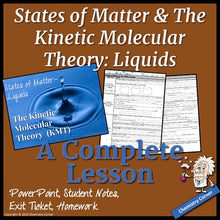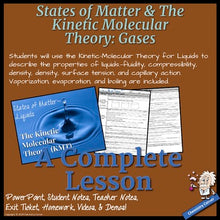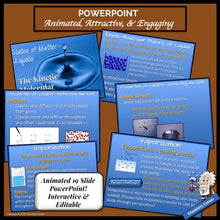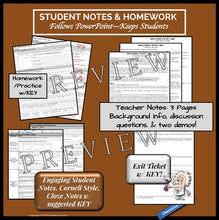In this lesson, students will apply the Kinetic-Molecular Theory of Liquids to the particular properties of liquids: fluidity, compressibility, density, diffusion, surface tension, and capillary action. The lesson includes an editable, animated PowerPoint introducing the basic assumption behind the Kinetic-Molecular Theory that all particles of matter are in constant motion. Vaporization, evaporation, and boiling are compared at the end of the lesson in order to have these straight before going into phase changes.
NGSS:
HS-PS2 Structure & Properties of Matter
HS-PS1-1: Describe and classify different kinds of materials by their observable properties.
DCI: PS1.A: Different kinds of matter exist and many of them can be either solid or liquid, depending on temperature. Matter can be described and classified by its observable properties.
Science & Engineering Practices—Constructing Explanations: Make observations to construct an evidence-based account for natural phenomena.
Cross-Cutting Concepts—Patterns: Patterns in the natural and human designed world can be observed.
Lesson Objectives:
-
State the Kinetic-Molecular Theory of Matter.
-
Relate the Kinetic-Molecular Theory of Liquids to the particular properties of liquids.
-
Describe the basic properties of gases including fluidity, compressibility, density, diffusion, surface tension, and capillary action.
-
Define vaporization, evaporation, and boiling.
-
Relate intermolecular forces, kinetic energy, and vapor pressure to evaporation and boiling.
Prior Knowledge:
None
Lesson Duration: One –two class periods
Included in This Resource:
-
PowerPoint presentation (19 slides), animated an editable, with two embedded videos
-
Student Guided Notes (Cornell Style Cloze Notes)
-
Suggested Key for student notes
-
Teacher Notes with discussion questions, background info, and two demonstrations
-
Check for Understanding Exit Ticket w/KEY
-
Homework/In Class Practice w/KEY
Teacher Prep Time: Just print and go!
Note on the PowerPoint: The PowerPoint included in this product is editable. It is also animated, which means that it may appear busy or overlapping in the slide edit mode, but will be awesome in the slide show mode! Please don’t edit the PowerPoint until you have seen it in the slide show mode!
This lesson is appropriate for grades 9-12 chemistry. Not appropriate for Middle School.
This will be a lesson you will want to use year after year!
Chemistry Corner
*************************************************************************************
Check out these other products that you may be interested in:
States of Matter & the Kinetic-Molecular Theory: Gases
BellWork/Warmups Editable for the Entire Year: Chemistry
Chemistry Doodle Notes for the Year: A Growing Bundle
High School Chemistry Year Curriculum
*************************************************************************************
Chemistry Corner’s PowerPoints are perfect for the flipped classroom. However, please read the Copyright Terms below before using it as such. Thanks!
LICENSING TERMS: By downloading this product, you own a license for one teacher only for personal use in your classroom. Licenses are non-transferable, meaning they cannot be passed from one teacher to another. No part of this resource is to be shared with colleagues or used by an entire grade level, school, or district without purchasing the proper number of licenses. I you are a coach, principal or district interested in transferable licenses to accommodate yearly staff changes, please contact beth@chemistrycorner.com.
COPYRIGHT TERMS: ©Chemistry Corner. Please note – all material included in this resource belongs to Chemistry Corner. By downloading, you have a license to use the material, but you do not own the material. This resource, or any portion of this resource, may not be uploaded to the internet in any form, including classroom/personal websites or network drives, unless the site is password protected and can only be accessed by students—no other teachers or anyone else on the internet.








